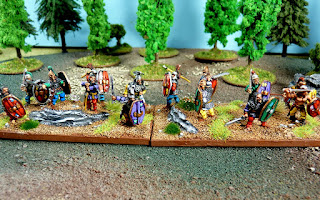For my Black Army of Hungary project, I'm changing things up. I've got a system for basing and painting that I use faithfully on every army. This time, I've decided to look for ways to do things differently. Experiment. Change it up. Right out of the gates, I'm having doubts. I've suppressed them by telling myself I can't judge the changes until it all comes together at the finish line. But I judge. And worry. After all, I'm an old dog.
 |
| Please lord, don't let the red devil kill me in my sleep. |
I've got 100+ foot and 100+ mounted figures to paint. Almost half of the figures have shields. To scratch-paint heraldry on this many shields, I've got to find ways to save time.
Glue Gun: First up is a trick I learned from
Lurkio, 15mm modeler and painter extraordinaire. I dug up an old glue gun and I'm hot gluing the cavalry to popsicle sticks. If you've painted Essex horse, you know how much time this'll save. Essex horses are exquisite, my favorite in 15mm, but their bases are easily bent or twisted. That makes it nearly impossible to put a spot of PVA glue down and call it good. The trick with the glue gun is to have the figure in hand and press hard right after the glue goes down. One press and no fiddling to make the bases flat and figures stand up straight.
Army Painter colored primer: Though quite pricey, I grabbed a bunch of Army Painter colored primers which I'll use to full effect. By priming a strip of mounted figures with a variety of browns, black or grey, I'll have eliminated the step of blocking in the primary color of the horse. I'll use a heavy wash over the blocked color and work detail and a highlight in when I paint the tack. The beauty of this technique is that you get shadowing similar to black lining without the difficulty of painting over blackened tack.
Glue Man to Horse: I've always painted riders separately from their mount but this time, I'm gluing the figure to the horse prior to priming to save time. For many poses, Essex has already done this for me! I don't want to work up from a variety of basecoat colors so I'll go over all riders with black. The black shadows the hard-to-paint places between the rider and his mount. And it'll lend itself to a darker effect that I'm looking for in my Black Army.
Since I'm using black on all the riders, I'll paint faces with black plus flesh combo. At 3 feet + viewing , it looks quite good in 15mm.
 |
| Army Painter colored primer in action. |
Flock it all: I'm also changing up my flocking. I once made the mistake of using too dark a color in my basing, which resulted in my cavalry being swallowed up by the color of the bases. I found a
very light colored Woodland Scenic ballast called Buff. It is so light it's kind of freaking me out. I'm going to stick with it because it should pay out with all of the cavalry & the variations of brown I'll use in painting them. I've had to remind myself that the point of basing is to showcase the figures. If the point of the basing was to realistically display ground cover, I'd use the "all green" flocking method. This one has a serious downside if I hate it at the finish line.
Accept feedback: For me, painting is a quiet, solitary experience. Some of you fellows belong to painting clubs and for you, painting is a social event. I've even heard of painters who paint via webcam just to get conversation and feedback as they go. When I mentioned this idea to my family, they thought webcam painting was a little over the top. I should point out that my kids are teens and thus, my very exsistence is a bit of an embarrasment to them!
For now, I'll settle for sharing photos. My friend Gilles already pointed out some of my work was a bit dark. I knew it to be true but I needed to hear it from someone else before going back and redoing highlights a tone higher. In 15mm, as in life, you just can't be subtle!























